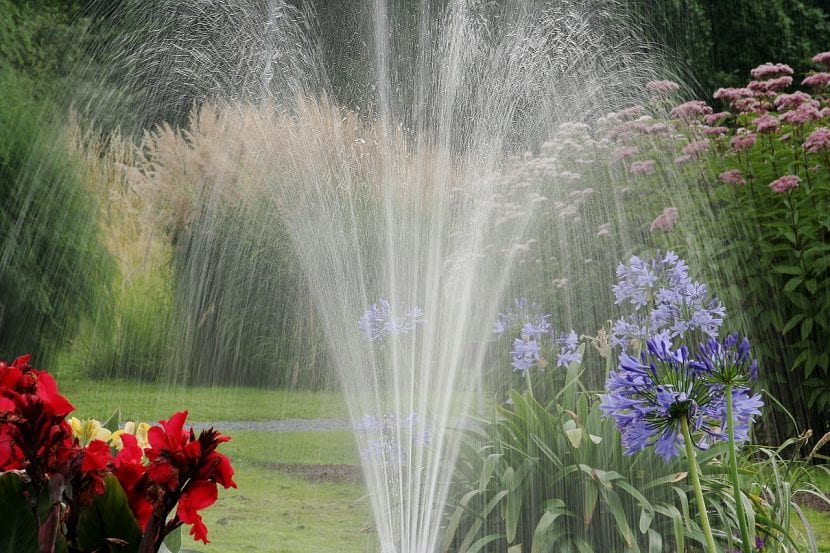
One way to get plants to get not only water, but also the moisture they need is through sprinkler irrigation. This system is very interesting, since despite what it may seem, it does not consume as much water as furrow or flood irrigation. And that's not to mention that it has many more advantages that are really interesting.
So lets see what is sprinkler irrigation and what do you need to be able to install it in your garden.
What is it?
It is a way of »imitating» the rain. The rain, if it falls gently but constantly, allows the roots of the plants to absorb it better than if it falls in a torrential way, since the soil has more than enough time to filter it inwards. Therefore, sprinkler irrigation is a highly recommended method to water plants that are growing, for example, in limestone soils or with a tendency to compact, although of course it can be installed in gardens or orchards that have another type of soil without problems.
What do you need to install it?
In order to install this type of irrigation system, the following is needed:
- Water source: well, river, lake, reservoir.
- Power source: electrical, photovoltaic, fuel, gravitational, etc.
- Sprinkler irrigationSprinklers, pipes, valves and filters, plus elbows and teas to tie it all together.
What are the advantages and disadvantages?
Advantages
The advantages of this irrigation system are the following:
- Can be used on sloping terrain.
- The water is gently distributed over the entire desired area.
- You can dose the water.
- Water consumption is less than that required by other systems, such as flood irrigation.
Drawbacks
The drawbacks are the following:
- During the warm months, the water that remains on the leaves, combined with the high temperatures, can cause the appearance of fungi.
- The water consumption is greater than that required by the drip irrigation system.
- The distance between the sprinklers must be well determined to achieve a uniformity coefficient that exceeds 80%.

Has it been useful to you?
Hello again Monica.
I have a sea of doubts about some trees that I have been acquiring, I bought two and I am going for 8, this has hooked me but there are dozens of doubts I have. The nurseryman where I buy tells me that it is crazy to buy potted trees, but I have no other choice and I love them.
I have them in pots, because having a little field is a dream for me, I would settle for 20 m2, but hey, it can't be and that's why on my modest terrace I try to do my best.
I have two olive trees, one from last year about a quarter high but with a 2 cm stem. and another 80 cm. which is a rod that I bought 4 days ago which I have to transplant right now. I wanted to know if it would be good to cut in half this last year to try to shape it into a tree, like bonsai.
I have a freshly bought self-fertile cherry tree that I have already transplanted.
A plum tree that I have to transplant but I am not sure which substrate to use, I have substrate, farmland, worm castings, diatomaceous earth, river gravel of watt sizes. You tell me what you think I do.
An orange tree from last year that I don't know if it's time to transplant, how can I know if the pot is small?
Puff, I would keep asking you but I don't want to bluff, hehe.
If I could put photos of you maybe it would be better, tell me if you can.
Well, thank you so much for your help.
José
Hello Jose.
You're not alone! I am also one of those who buy large plants that later I have no choice but to have them in pots, such as the Horse Chestnut, which you will see when I say to grow (it can reach 25m). Now it is tiny and it is nothing more than a thin stem with 4-5 branches, but it already measures its 50cm good: s
Well, I'm answering you:
-Olives: rather than giving them a drastic pruning -which I am sure they would hold up well, but I do not recommend it- I advise you more to cut the branches little by little, starting with the main one. A simple cut to about 2-3cm will force them to take out lower branches, and incidentally to thicken the trunk a bit. The following year you can lower them more.
-Cherry: good. Leave it that way for now. The following year, when you get used to him and he to you, you can start trimming the branches if he needs it.
-Ciruelo: it is not a demanding fruit tree. You can plant it in a substrate mixed with 30% small-grained river gravel (4mm or less). You can sprinkle diatomaceous earth on the surface to prevent mealybugs and other pests. The dose is about 35g per liter of water (use a watering can; the sprayer clogs quickly).
-Naranjo: if it has never been transplanted, you can do it without problems. It is more than likely that its roots have occupied the entire pot. However, you can wait until the soil is dry and try to remove it - not completely, just a little bit - from the container. If the root ball does not begin to crumble or if it is difficult for you to remove it, it is because it needs a transplant.
To send photos better by Facebook.
A greeting.